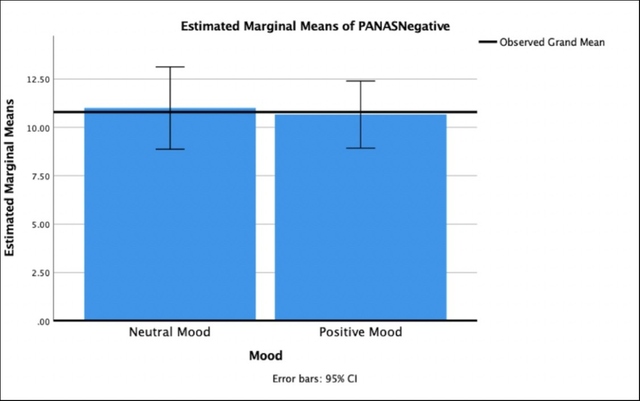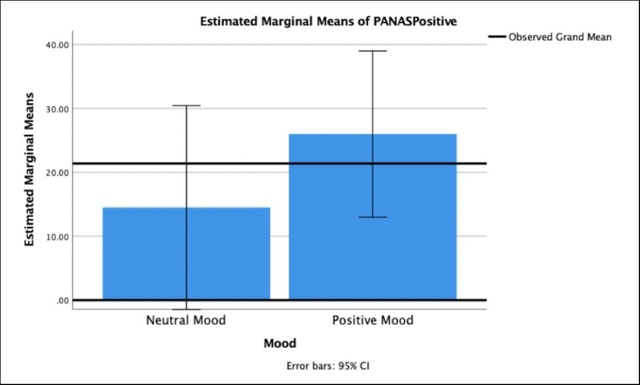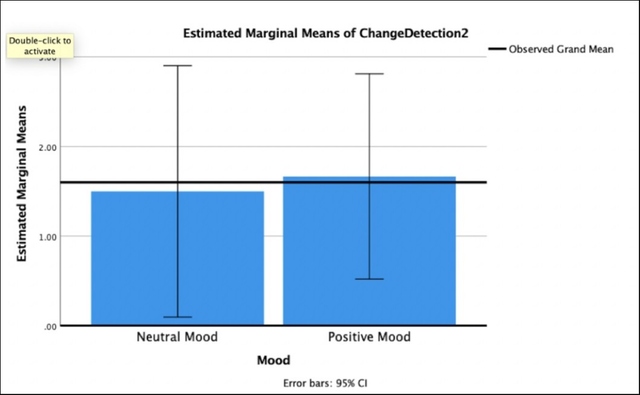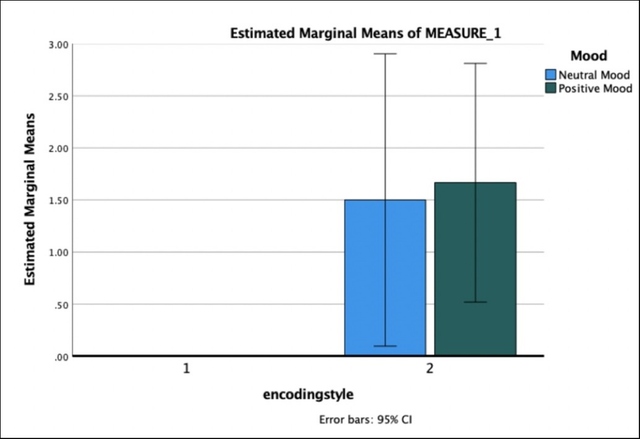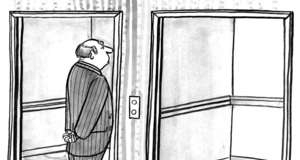Change Blindness: The Influence of Positive Mood on Change Detection in Visual Scenes
By
2022, Vol. 14 No. 06 | pg. 1/1
IN THIS ARTICLE
KEYWORDS
AbstractChange blindness is the finding that people often fail to notice substantial changes between different views of a visual scene. The current study investigated the effect of mood states on people’s ability to detect changes, by comparing participants’ performance on a motion picture change blindness task, after a positive or neutral mood induction. The results found that participants in the positive mood condition had no advantage over the neutral mood condition in the number of unusual changes they detected. This null finding was found for both intentional and incidental encoding. However, change detection was significantly better for intentional encoding compared to incidental processing. No interaction effect was found between mood and encoding intention. The results indicate that positive emotions lend no adaptive or enhancing functions to cognitive processing that would alleviate change blindness. Change blindness describes the robust scientific finding that people often fail to notice changes in visual scenes (Simons & Levin, 1998; Simons, 2000; Levin et al., 2002). Even substantial changes are undetected when views of a scene are briefly interrupted by film cuts, saccades, blank screens, blinks, or other occlusions (Simons, 2000). Change detection failures have been found in both artificial scenes (Scholl, 2000) and in natural, real-world scenes or interactions (Simons & Levin, 1998). In addition, change blindness occurs whether or not observers are that changes will occur, regardless of the incidental or intentional nature of the encoding task (Levin et al., 2002; Bendall & Thompson, 2015). While change blindness is explained by a variety of interrelated perceptual and representational systems (see Levin & Simons, 1997), many researchers, such as Rensink et al. (1997), highlight the key role of attentional processes in change detection (Simons, 2000). Some studies have shown that changes are more easily and readily identified when they occur in the center of visual attention (Rensink et al., 1977). This is because focused attention is necessary to detect changes and create more detailed representations of objects of high visual interest (Rensink et al., 1997). Therefore, change blindness demonstrates how people’s attentional capacity is often limited to focal details, and our internal representations of visual experiences are much more sparse and less detailed than how we intuitively think (Simons, 2000). People cannot attend to and retain everything they see, because the visual world is rich and highly cluttered with information. Instead, we selectively prioritize the details of a visual scene that are most relevant, and are the focus of our attention, while less relevant aspects are missed and go unnoticed, even when they change substantially between visual scenes (Levin & Simons, 1997).The implications of change blindness are double-sided; our sparse representations both limit our performance on attentional tasks, but are also an essential part of our daily visual processing (Levin & Simons, 1997; Davies & Hine, 2007). As an adaptive feature of our visual processing and representational system, change blindness might be critical to our experience of visual continuity in everyday life, by selectively filtering out information between views, and preserving only the essential representations to make sense of scenes and events (Levin & Simons, 1997). This does not mean, however, that change blindness does not create issues in our lives. Potentially disastrous real-life implications of change blindness are demonstrated by studies involving driving (Galpin et al., 2009) and eyewitness testimonies (Davies & Hine, 2007). For instance, a study by Davies and Hine (2007) found that 61% of participants who watched a video enactment of a burglary failed to notice that the suspect changed during the video. The purpose of the current study is to investigate potential factors that might attenuate and reduce change blindness to improve visual change detection. Specifically, the study aims to generate preliminary findings on how emotions and mood can influence change blindness, a largely unstudied area in the current literature. We propose that mood may have important implications for visual change detection, based on prevalent theoretical and empirical work from other researchers (Frederickson, 2001; Rowe et al., 2006). Notably, according to Fredrickson’s (1998) broaden-and build theory, positive emotions have an adaptive function to broaden our “thought-action repertoire,” while building skills and resources in the long-term (p. 303). A considerable body of cognitive research has documented this enhancing effect of positive emotions on a variety of cognitive functions, including memory, perception, attention, problem-solving, reasoning, and creative thinking (see Fredrickson, 1998 for a review). Of particular interest to the current study is how positive affect can broaden the scope of attention, allowing people to notice more peripheral details of a visual scene that they would not otherwise detect (Rowe et al., 2006). For instance, Rowe et al. (2006) demonstrated that, when participants are in positive mood states after a musical mood induction, visual attention becomes broadened and less selective. Given that positive mood can enhance visual attention to detect otherwise unnoticed details (Rowe et al., 2006), and that change blindness is largely explained by limited capacity attentional systems (Rensink et al., 1997), it is plausible to predict that positive mood can enhance people’s ability to detect changes in visual scenes. However, to date, there has only been one study specifically investigating the effect of mood on change blindness (Bendall & Thompson, 2015). Bendall and Thompson’s (2015) preliminary findings concluded that positive mood has no effect on change detection in a computerized change flicker task. However, Bendall and Thompson’s (2015) study included two important limitations: (1) the study used artificial visual scenes and geometric objects, rather than naturalistic visual stimuli that are more complex and similar to real-life experiences; and (2) the study only examined intentional encoding processes, where participants were deliberately instructed to look for changes. The current study attempts to extend on these findings by using a more realistic motion picture change detection task. In addition, our study takes into account the viewer’s intention, by examining both intentional and incidental change detection. To investigate mood state as the main independent variable of interest, participants completed either a positive or neutral mood induction procedure prior to a change detection task (see Rowe et al., 2006 for mood induction materials). To measure change detection performance, the dependent variable was the number of unusual changes reported after viewing a short motion picture clip (see Levin & Simons, 1997). A greater number of changes reported indicates better performance on the change detection task, and reduced change blindness. Given the considerable amount of literature that documents enhancing effects of positive emotions on cognition (Fredrickson et al., 1998), we hypothesized that participants who have undergone positive mood induction would report more changes than those in the neutral mood condition, demonstrating enhanced attentional capacity and lower change blindness. Another independent variable we examined was the encoder’s intention. Participants performed both intentional and incidental change detection by watching the motion picture clip twice: once with instructions to look for changes, and once without. Previous studies have found that people tend to perform more poorly on incidental change detection tasks, where participants have received no instructions to look for changes (Beck et al., 2007; Davies & Hine, 2007). Therefore, we hypothesized that participants would detect more unusual changes when they were intentionally looking for them, compared to when encoding is incidental. In addition, although we could not make a definitive hypothesis based on available knowledge, we considered any interaction effects that may have existed between mood and encoding intention, such that the advantage of intentional over incidental encoding may depend on one’s mood state. As the experiment was conducted completely virtually, it was important to ensure that all participants received the same instructions, in order to control for any variation between participants that is caused by experimenter differences. This variable was easily controlled by sending all participants the exact same slides presentation with detailed, pre-written instructions to guide them through the study. MethodologyParticipantsFive undergraduate students from the University of Toronto participated in this study. Participants were enrolled in a laboratory course on human memory research, and voluntarily recruited through an online group messaging platform between classmates. MaterialsConsent FormThe consent outlined a general description of the study (ex. “investigation on the relationship between mood and attention”), as well as participants’ rights to withdrawal, privacy, and confidentiality. Prospective participants completed a Google Forms questionnaire that included a detailed description of what the experiment entailed, and a question that prompted them to indicate their understanding and willingness to participate. Google Sheets PresentationTo allow for participants to complete the experiment without an experimenter present, a Google Sheets Presentation included all of the necessary materials (mood induction stimuli, mood/affect questionnaire, and change detection task), as well as detailed instructions on how to proceed through the experiment. There were two versions of the presentation, which were completely identical apart from the mood induction stimuli (one positive, one neutral). Mood Induction StimuliFor the positive mood condition, the mood induction task included a short recording of “happy” music (mp3 file), using the same classical piece selected in Rowe et al.’s (2006) positive mood task. The music recording was a passage from Bach’s Brandenburg Concerto No. 3 (First Movement), and played for 6 minutes and 1 second. The neutral mood induction included a text passage describing facts about Canada, which was also taken from Rowe et al.’s (2006) neutral mood task. The passage was 4 pages long, size 12 Comic Sans font, and single-spaced (Google Docs file). It included a list of various facts about Canada’s history, economy, transportation, ecosystems, etc. Mood/Affect QuestionnaireTo confirm that the mood manipulation was effective, participants completed a brief questionnaire about their current mood/affective state (Watson et al., 1988). Items from the questionnaire (accessed via Google Forms) was taken from the Positive and Negative Affect Schedule (PANAS), where participants responded to 20 items describing positive and negative mood states (ex. Interested, Distressed, Excited, Upset, etc.). They indicated the extent to which they currently related to each mood descriptor, from a scale of 1 to 5 (1 = Very slightly or not at all, 2 = A little, 3 = Moderately, 4 = Quite a bit, 5 = Extremely). Separate scores for Positive Affect and Negative Affect were calculated from the items. Based on Waston et al.’s (1988) assessment, both Positive Affect and Negative Affect scales have acceptably high reliability scores (ex. internal consistency or Cronbach’s alpha = .84 to .90) and validity scores (ex. item validity correlations from .87 to .96, and convergent validity correlations from .89 to .95). See Appendix A for additional items and calculation procedures. Change Blindness Task (Motion Picture Clip + Questionnaires)The change blindness task involved viewing a brief motion picture clip (36 seconds, colourized) depicting a conversation between two characters. The clip was taken from Levin & Simon’s (1997) change blindness study. Each time the scene cut, there was a continuity error. For example, an actor was shown wearing a scarf in one shot, but the scarf disappeared in the next cut. In total, there were nine of these unusual changes in the clip. Participants viewed the clip from an embedded Youtube video on their personal computers. After each viewing of the clip, participants responded to a short questionnaire (via Google Forms) asking them to report any unusual changes they detected in the clip. After the initial viewing, the first questionnaire included two questions: (1) “Did you notice any unusual differences from one shot to the next where objects, body positions, or clothing suddenly changed?,” to which they responded Yes or No, and (2) “If you responded Yes to the above question, please describe any changes you noticed,” where participants freely reported the changes they detected (Levin & Simons, 1997, p. 502). After the second viewing, the second questionnaire included one free-write question: “Please describe any unusual changes you noticed in the video.” Debriefing FormThe debriefing form included a detailed description of the goals and methods of the study, as well as participants’ contribution to the current research. In the Google Forms page, participants indicated whether or not they have understood the implications of the study and the value of their participation. ProcedureAn experimenter sent all the necessary materials (in a Google Slides presentation) to the participants’ preferred emails, at a scheduled time. Participants were instructed to carefully follow the instructions in the Google Slides presentation, and complete all instructions in one sitting. At the beginning of the presentation, participants completed the mood induction task, which differed depending on their assigned mood condition. In the positive mood condition, participants were instructed to listen to a music recording (embedded in the presentation). The on-screen instructions asked them to “relax, clear your mind, and enjoy the piece.” In the neutral mood condition, participants were redirected to a Google Doc with the text passage on facts about Canada, which they were instructed to read through either silently or aloud. When they had completed the mood induction task, they were instructed to return to the presentation, and continue with the next task. Participants then completed the change detection task. First, they were instructed to watch the motion picture clip (from Levin & Simons, 1997), which was embedded in the presentation. For this initial viewing, participants were not instructed to deliberately look for changes, only to watch the clip. Then, participants were redirected to a Google Forms questionnaire, where they responded to two questions: (1) “Did you notice any unusual differences from one shot to the next where objects, body positions, or clothing suddenly changed?,” and (2) “If you responded Yes to the above question, please describe any changes you noticed.” When participants finished their initial viewing and response to the clip (for the incidental encoding condition), they returned to the presentation and received the following instructions: “In the video you just watched, unusual changes occurred every time the camera angle changed. Next, you will be watching the same video again. This time, try to spot and make note of any changes.” Participants watched the same clip again, this time intentionally looking out for unusual changes. They responded to another Google Forms survey, where they were asked to “describe any unusual changes you noticed in the video.” They were then asked to exit the presentation. Following participants’ completion of the experiment, the experimenter recorded the number of changes detected after each viewing of the motion picture clip. The experimenter also calculated Positive Affect and Negative Affect scores based on participants’ responses to the PANAS questionnaire. See Appendix A for PANAS calculation instructions. A univariate analysis of variance (ANOVA) was conducted to compare the difference in number of changes detected between mood conditions, for both intentional and incidental viewings of the video. Another set of univariate ANOVA tests were conducted as a manipulation check, to compare the Positive and Negative PANAS scores between mood conditions. In addition, a paired-samples t-test was conducted to compare change detection performance for incidental and intentional conditions. Lastly, a mixed ANOVA was used to test for any interaction effects between mood and encoding intention. ResultsManipulation CheckA univariate ANOVA indicated that there was no significant difference in Negative Affect PANAS scores for positive and neutral mood conditions, F(1, 4) = .15, p = .72. Figure 1. Negative PANAS for Mood Conditions
Participants in the positive mood condition had higher Positive Affect scores than those in the neutral condition, but this difference was not statistically significant, F(1, 4) = 3.16, p = .17. Figure 2. Positive PANAS for Mood Conditions
Mood, Intention, and Change BlindnessAfter the first, incidental viewing of the motion picture clip, 100% of participants responded that they did not detect any unusual changes. Therefore, there were no differences between positive and neutral mood conditions. Following the second, intentional viewing of the clip, participants in the positive mood condition detected more changes than those in the neutral mood condition, but this difference was not significant, F(1, 4) = .08, p = .79. Figure 3. Change Detection for Mood Conditions (Intentional)
Participants detected significantly more changes in the intentional encoding condition compared to incidental encoding, t(4) = -6.53, p = .003. Table 1. Paired Samples t Test (Intentional vs. Incidental)
Lastly, there was no significant interaction found between mood condition and encoding intention, F(1, 4) = .08, p = .79. See Appendix B for raw data from the current study. Figure 4. Mixed ANOVA Results (Mood x Intention)
DiscussionThe current study aimed to investigate the effect of positive mood on change detection, and could not conclude that positive emotions have an enhancing effect on attentional processes to reduce change blindness. Results indicate that participants did not detect significantly more changes in a motion picture clip after a positive mood induction, compared to a neutral mood induction. In fact, after the first, incidental viewing of the clip, all participants indicated that they did not perceive any unusual changes in the video, suggesting that the positive mood condition had no advantages in change detection compared to the neutral mood condition. Although the positive mood condition did perform slightly better than the neutral mood condition on the second viewing, this difference was not found to be statistically significant. These findings indicate that a positive mood induction provides no benefits to protect people against change blindness. Therefore, results were inconsistent with our initial hypothesis that positive mood states should enhance attentional capacity and reduce change blindness, given the broaden-and-build theory of positive emotions (Fredrickson, 2001). An unfortunate result from the current study was the failure to pass the manipulation check, such that participants in the positive mood condition did not report significantly higher levels of positive affect, or lower levels of negative affect, compared to the neutral condition. This finding indicates that the mood manipulation was ineffective, or not strong enough to produce differences in self-reported affective states between mood conditions. However, the small sample size might explain the null effect of the mood manipulation, as a larger sample might have enough power to detect larger group differences in affect. The current study did, however, confirm our second hypothesis that intentional, deliberate encoding resulted in enhanced change detection compared to incidental encoding, where participants were unaware that changes would appear, and were not instructed to look for anything unusual. This finding is consistent with previous change detection studies that have found that intentional encoding can attenuate deficits in change blindness (Davies & Hine, 2007). However, the current study did not find any interaction effects between mood and encoding intention, and cannot conclude that positive mood can either further enhance the benefits of intentional change detection, or alleviate the disadvantages of incidental processing. Several limitations of the current study may explain some of these null findings. Perhaps the most important limitation of the current study was the limited sample size, which suggested that the study did not enough power to detect differences between conditions. The current study should serve as a pilot investigation to encourage future researchers to extend on these methodologies, by investing more resources into the recruitment of a large, representative sample. Additionally, although the current study attempted to improve the real-life generalizability of Bendall & Thompson’s (2015) change detection paradigm, we acknowledge that motion picture stimuli are still much less rich in visual information than in real world settings. Thus, future studies are encouraged to investigate the influence of mood on change blindness in completely naturalistic interactions, much like in Simons & Levin’s (1998) experiment with unsuspecting pedestrians. Lastly, the current study was limited due to potential order effects that might have existed. Because the intentional encoding trial was always completed during the second viewing of the motion picture clip, it is possible that participants detected more changes in the intentional encoding condition, simply because they had seen the clip once already. Also, because mood induction effects may be short-lived, positive mood effects may have worn out towards the end of the experiment. Therefore, future studies should consider these order effects by using a between-subjects design to investigate the effect of encoding intention on change detection, and also include multiple mood “boosters” (or short mood inductions) throughout the experiment (see Rowe et al., 2006). ConclusionThe current study examined the effect of positive mood on change blindness, and showed that positive mood likely has no benefits over neutral mood states for detecting changes in visual scenes. This finding was found for both intentional and incidental styles of encoding, when viewing a motion picture clip with unusual changes across film cuts. Future investigations are encouraged to further examine the link between mood and change blindness with improved methodologies and a larger sample size to better detect differences between groups. ReferencesBendall, R. C. A., & Thompson, C. (2015). Emotion has no impact on attention in a change detection flicker task. Frontiers in Psychology, 6, 1–9. https://doi.org/10.3389/fpsyg.2015.01592 Davies, G., & Hine, S. (2007). Change Blindness and Eyewitness Testimony. The Journal of Psychology, 141(4), 423–434. https://doi.org/10.3200/jrlp.141.4.423-434 Fredrickson, B. L. (1998). What Good Are Positive Emotions? Review of General Psychology, 2(3), 300–319. https://doi.org/10.1037/1089-2680.2.3.300 Fredrickson, B. L. (2001). The role of positive emotions in positive psychology: The broaden-and-build theory of positive emotions. American Psychologist, 56(3), 218–226. https://doi.org/10.1037/0003-066x.56.3.218 Galpin, A., Underwood, G., & Crundall, D. (2009). Change blindness in driving scenes. Transportation Research Part F: Traffic Psychology and Behaviour, 12(2), 179–185. https://doi.org/10.1016/j.trf.2008.11.002 Levin, D. T., & Simons, D. J. (1997). Failure to detect changes to attended objects in motion pictures. Psychonomic Bulletin & Review, 4(4), 501–506. https://doi.org/10.3758/bf03214339 Levin, D. T., Simons, D. J., Angelone, B. L., & Chabris, C. F. (2002). Memory for centrally attended changing objects in an incidental real-world change detection paradigm. British Journal of Psychology, 93(3), 289–302. https://doi.org/10.1348/000712602760146224 Rowe, G., Hirsh, J. B., & Anderson, A. K. (2006). Positive affect increases the breadth of attentional selection. Proceedings of the National Academy of Sciences, 104(1), 383–388. https://doi.org/10.1073/pnas.0605198104 Scholl, B. J. (2000). Attenuated Change Blindness for Exogenously Attended Items in a Flicker Paradigm. Visual Cognition, 7(1–3), 377–396. https://doi.org/10.1080/135062800394856 Simons, D. J. (2000). Current Approaches to Change Blindness. Visual Cognition, 7(1–3), 1–15. https://doi.org/10.1080/135062800394658 Simons, D. J., & Levin, D. T. (1998). Failure to detect changes to people during a real-world interaction. Psychonomic Bulletin & Review, 5(4), 644–649. https://doi.org/10.3758/bf03208840 The Ohio State University. (2020). Positive and Negative Affect Schedule (PANAS-SF). The Ohio State University, College of Medicine. https://ogg.osu.edu/media/documents/MB%20Stream/PANAS.pdf Watson, D., Clark, L. A., & Tellegen, A. (1988). Development and validation of brief measures of positive and negative affect: The PANAS scales. Journal of Personality and Social Psychology, 54(6), 1063–1070. https://doi.org/10.1037/0022-3514.54.6.1063 AppendixSuggested Reading from Inquiries Journal
Inquiries Journal provides undergraduate and graduate students around the world a platform for the wide dissemination of academic work over a range of core disciplines. Representing the work of students from hundreds of institutions around the globe, Inquiries Journal's large database of academic articles is completely free. Learn more | Blog | Submit Latest in Psychology |

